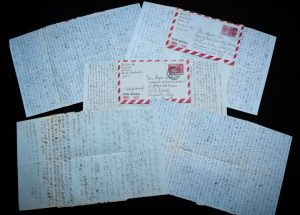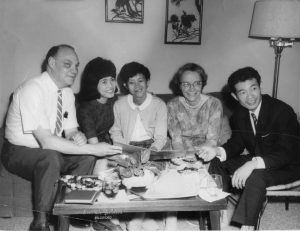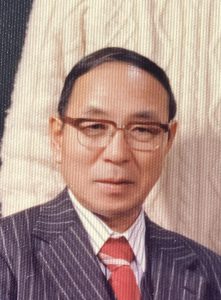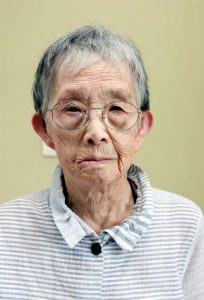Making their voices heard — 60 years after Hiroshima-Nagasaki World Peace Pilgrimage: Letters from family support A-bomb survivor’s journey
Jul. 15, 2024
“Your true ability will be demonstrated only after you overcome hardships,” wrote husband
Shizuko Abe keeps on hand more than 30 letters she exchanged with husband, Saburo
by Hiromi Morita, Staff Writer
In 1964, 60 years ago, the Hiroshima-Nagasaki World Peace Pilgrimage took place, with A-bomb survivors traveling to eight nations, including those in possession of nuclear weapons, to share the reality of the atomic bombings. Shizuko Abe, 97, is an A-bomb survivor who joined the pilgrimage from Hiroshima. Ms. Abe has carefully held on to more than 30 letters she and her husband, Saburo (who died in 1992 at age of 73), exchanged while she was on the pilgrimage. Their correspondences offer a glimpse into Ms. Abe’s efforts and hardships she experienced during the long journey to other nations as “a living witness of the atomic bombing.” At the same time, the letters also convey the enthusiasm of the people who sent off and supported the pilgrimage group from the A-bombed cities.
The letters were discovered in Saburo’s study last year in the fall, when Ms. Abe’s family was cleaning out the family home. Around 40 letters were kept there, including those addressed to Shizuko from friends and relatives. Of that total, 34 were correspondences between Shizuko and Saburo. It is assumed that the couple wrote a letter to each other every few days, based on dates used in the letters and postmarks, as well as other such information. All of the airmail letters were made up of a combination of letter paper and envelope.
The peace pilgrimage idea was originally proposed by the late Barbara Reynolds, an American peace activist who was living in Hiroshima at the time. Two years earlier, Ms. Reynolds took two A-bomb survivors, including the late Miyoko Matsubara, on a tour of the United States, the former Soviet Union, and other countries. Based on reactions to that trip, Ms. Reynolds set her sights on launching a similar activity on a larger scale. Citizens from the A-bombed cities who had agreed to the proposal supported the plan by collecting donations and sending messages to the pilgrimage group.
Around 40 members, including A-bomb survivors and interpreters selected through an open screening process, embarked on the overseas journey. The group arrived in Hawaii on April 21, and over the course of about two-and-a-half months, traveled to the mainland United States, Europe, and the former Soviet Union.
In those days, with the exchange rate at 360 yen to the dollar, overseas travel was an unattainable luxury for many Japanese. As most families did not even have a telephone, letters were an important means of communication.
(Excerpt from Saburo’s letter) I asked my mother and our children to write this last night (dated April 21)
As soon as the day Shizuko left Japan, Saburo apparently asked his mother, who lived together with the family, and their children – two boys and a girl – to write her a letter, which had the appearance of a traditional Japanese square card filled with messages of encouragement from many different people. The children’s messages revealed the love shared by the family and included such sentiments as “I’ll wait for your return in good spirits,” along with “Don’t worry about anything at home,” and “Please don’t worry about us and make sure to fulfill your goals.”
At that time, Shizuko was engaged in house work and childrearing as a homemaker while also working in the farm fields in the area of Kaita-cho, Hiroshima Prefecture. In Shizuko’s letters to Saburo, she often described her concerns about taking care of the house and rice fields during her absence. In response, Saburo wrote the following.
(Excerpt from Saburo’s letter) We eagerly look forward to your letters, but they are not at all interesting, with so many instructions about what to do while you are away. Instead of worrying about us, please write as much as you can about what you find strange, interesting, or impressive on your trip (dated the 28th).
The pilgrimage group spent the first month and a half in the United States. In addition to the mission of sharing their experiences in the atomic bombing in the nation that dropped the bombs, it was a group trip to a nation with a different climate and culture. Shizuko apparently became exhausted by the difficulties on the journey and sometimes seemed to have weakened in spirit.
(Excerpts from Shizuko’s letters) I always think of our kids and cry (dated the 27th). I want to go home now (dated May 7).
(Excerpts from Saburo’s letters) To begin, let me complain about your letter. It is troubling to me that you wrote about how you always think of the children and cry (dated the 2nd). I cannot help but think “you somehow became homesick” … Your true ability will be demonstrated only after you overcome hardships (dated the 21st).
Shizuko wrote about how she thought of their children whenever she ate delicious food in the affluent United States. Recalling those days, she said, “I was comforted by my husband’s letters and felt reassured every time I learned through his correspondence that our kids were doing fine.”
(Excerpt from Shizuko’s letter) I am very busy every day. Please forgive me when I am unable to write, even though I know everyone is waiting for my letters (dated the 4th).
In the United States, the pilgrimage members were invited to speak on many occasions such as gatherings and meetings day after day, through arrangements made by local groups that were working to support Ms. Reynolds’s efforts. Shizuko said, “I would collapse onto bed and sleep like a log after reaching my host family’s home. I used to write letters in cars or airplanes while we were on the move.” From her letters it is clear that she interacted with Americans of goodwill during busy days and was having invaluable experiences.
(Excerpts from Shizuko’s letters) I feel my mental scars have truly been healed by the warm-hearted people here. Yesterday, I spoke four times but could do it with a bit of ease, because I’m somewhat used to it now (dated the 8th). Everyone we meet encourages us and tells us they learned about Hiroshima and Nagasaki through books and newspapers but never felt the reality so vividly as when they heard the stories we shared. They also thank us for gathering our courage to come all this way. The more places we visit, the more all members of our group gain courage (dated the 19th).
Real-time communication through letters is difficult. Saburo seemed a bit worried about his wife due to the lack of information. Citizens from the A-bombed cities who had sent off the pilgrimage were also exceedingly eager to learn of what was happening on the pilgrimage.
(Excerpts from Saburo’s letters) The Chugoku Shimbun has carried nothing like news about your journey for a long time. It has only carried short articles about your arrival in San Francisco and your meeting with former U.S. President Truman (dated the 12th). I think news about you all should be reported once a week at least … Everyone asks me nearly every day if you are already back or not. When I reply you will be back in July, they ask about where you are now. That’s how people are perceiving the situation here (dated the 21st).
Saburo himself must have wanted his wife’s activities overseas to be known more broadly.
Letters of encouragement from her friends were also discovered, including one from the late Kiyoshi Kikkawa, who was called “Atomic Bomb Victim No. 1” by revealing the keloid scars that remained on his back and condemning the atomic bombing. He wrote a letter of encouragement to her in New York. Even before the trip, Shizuko had relied on Mr. and Mrs. Kikkawa, with whom she enjoyed a relationship as family friends. Mr. Kikkawa wrote about Shizuko’s first and second sons when they visited him on a casual visit, adding, “I am sure you have experienced hardships from differences in climate as well as food and language barriers, but please take care of yourself and your health.”
On July 17, the Chugoku Shinbun will initiate a new feature article series titled “Making their voices heard — 60 years after Hiroshima-Nagasaki World Peace Pilgrimage.”
(Originally published on July 15, 2024)











